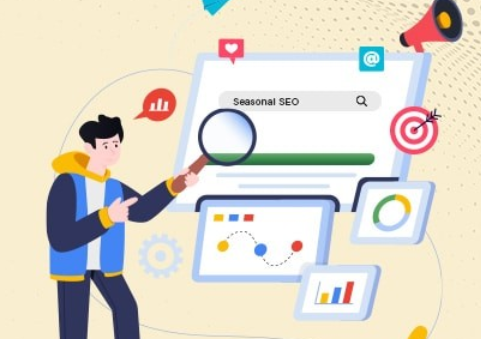SEO is often thought of as a long-term game, and it is. But within that long game are seasonal opportunities that can dramatically boost traffic, leads, and sales when timed correctly. Whether you’re running a local service business, targeting niche investors, or managing a national brand, having a seasonal SEO strategy can set your site apart from competitors who operate on autopilot.
In this guide, we’ll explore how seasonal SEO works, why it matters, and how to implement it across industries like real estate, roofing, HVAC, and more.
What Is Seasonal SEO?
Seasonal SEO refers to optimizing your website’s content and keyword targeting to align with recurring seasonal trends. This includes:
- Weather-related needs (such as winter roofing or summer A/C repair)
- Holiday shopping behavior
- Tax season, back-to-school, or end-of-year budgeting
- Local tourism booms
- Global investment cycles
While evergreen SEO focuses on consistent traffic throughout the year, seasonal SEO is about maximizing spikes in search demand that occur during specific months, quarters, or events.
Why Seasonal SEO Matters
People don’t search the same things every month. Search behavior changes with the calendar and that affects how your business is discovered online.
Smart seasonal SEO can:
- Bring in a flood of high-intent traffic
- Capture leads when purchase urgency is high
- Boost brand visibility around key events
- Shorten the sales cycle with timely offers
- Increase conversions by aligning with current needs
For example, homeowners don’t search for “emergency roof repair” in July the same way they do after a February storm. Likewise, Dubai sees an influx of global investors toward year-end as people look to diversify portfolios before closing their books. Optimizing content around those patterns isn’t just smart, it’s strategic.
See also: How Technology Is Changing Truck Accident Prevention
How Seasonal SEO Works
The process starts with identifying search trends tied to specific dates, seasons, or events. From there, content, metadata, internal links, and CTAs are adjusted to match that intent.
It involves:
- Trend-based keyword research
- Seasonal content calendars
- Time-sensitive landing pages
- Updating or republishing old posts
- Adjusting internal links to boost timely pages
- Redirecting campaign focus to match peak interest
For example, if you’re offering HVAC SEO services, you’d want to build campaigns that speak to “summer air conditioning tune-up” in April through June and “furnace installation” in September through November.
Seasonal SEO in Action: Industry Examples
Roofing
Roofing businesses experience big spikes during specific seasons such as spring leaks, summer installs, fall inspections, and winter emergencies.
With roofing SEO, seasonal timing can be applied to:
- Creating blog posts like “Spring Roofing Checklist” or “Preparing Your Roof for Winter”
- Launching service pages targeting searches like “emergency roof repair after storm”
- Running campaigns around local weather alerts
- Publishing testimonial content tied to seasonal jobs
The idea is to match local weather patterns and customer pain points as they happen, not months after.
HVAC Services
Heating and cooling businesses are among the most seasonal industries in local SEO. If your content isn’t aligned with temperature changes, you’re missing out on the highest-converting leads of the year.
For HVAC SEO, seasonal planning means:
- Promoting “AC tune-up specials” in late spring
- Launching “furnace repair” pages before winter hits
- Publishing pre-season checklists or maintenance guides
- Running geo-targeted content for specific temperature swings
Even FAQs can be seasonal. In July, “Why is my AC blowing warm air?” could become your top-performing blog post. In January, it might be “What temperature should I set my thermostat in winter?”
International Real Estate
Real estate sees heavy seasonal fluctuations, and when dealing with international property investments such as Dubai real estate, timing is even more important.
Investor behavior shifts based on:
- Fiscal year-end planning, especially Q4
- Tax incentives and reporting timelines
- Seasonal migration and tourism
- Expo events and global investment summits
For Dubai, the cooler months from October to March bring heavy investor traffic, vacation home interest, and real estate showings. A dedicated seasonal SEO strategy here might include:
- Updating listing pages with new ROI stats
- Promoting “year-end investment benefits”
- Running Q4-specific landing pages with lead forms
- Creating content like “Why Dubai Property is a Smart Move Before Year-End”
By aligning your SEO with seasonal investor behavior, you position your business at the right place and time.
How to Build a Seasonal SEO Calendar
You don’t need to guess. Google Trends, Ahrefs, and SEMrush all let you explore when specific terms rise and fall in search interest.
Here’s how to build a basic calendar:
- List seasonal events relevant to your industry
- Map keywords to those events
- Create or refresh content one to two months ahead
- Update meta tags and internal links
- Use schema markup
- Set reminders to review performance post-season
Let’s say your roofing company ranks well for “roof inspections near me.” You might see traffic climb every October when homeowners prepare for storms. Updating your post in August ensures it ranks just in time for the spike.
Bonus Tip: Refresh Instead of Rewriting
One powerful seasonal SEO hack is to reoptimize old content instead of writing new pieces from scratch.
For example, a blog titled “2022 HVAC Maintenance Tips” likely saw solid traffic last year. Instead of rewriting it, update the title and body for 2025, add internal links, freshen up stats, and change the publish date.
You now have seasonal content with age, authority, and new relevance created in under an hour.
Tools to Use
- Google Trends to spot seasonal peaks and valleys
- Exploding Topics for rising seasonal search topics
- SEMrush Keyword Magic Tool to filter by month-specific keyword volume
- AnswerThePublic to discover seasonal questions
- Google Search Console to review past seasonal traffic patterns
Final Thoughts
Seasonal SEO is one of the most underrated ways to drive high-intent traffic, improve conversions, and outperform your competitors without increasing ad spend. By planning ahead, optimizing content at the right time, and leaning into audience behavior, businesses can see big spikes in search visibility where it matters most.
Whether you’re preparing for the next heat wave with HVAC SEO, protecting homes with roofing SEO, or capturing global investor traffic with Dubai real estate SEO, timing your strategy isn’t just a bonus. It’s a competitive edge.
Most businesses wait too long. The smart ones prepare now. Want help building your own seasonal SEO calendar? Reach out to the experts who live and breathe it.

